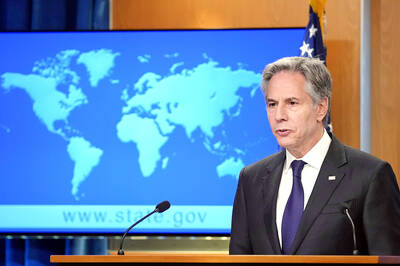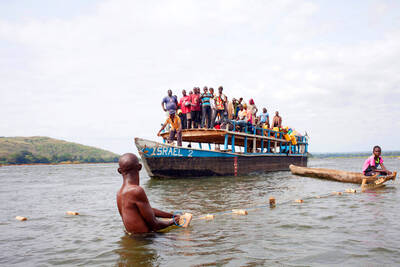The largest known bacterium — a vermicelli-shaped organism that was discovered in shallow mangrove swamps in the Caribbean and is big enough to be seen with the naked eye — is redefining what is possible for bacteria, Earth’s most ancient life form.
The bacterium, called Thiomargarita magnifica, is noteworthy not merely for its size — colossal for a single-celled organism at up to 2 cm long — but also because its internal architecture is unlike other bacteria, Scientists said on Thursday.
The DNA, an organism’s blueprint, is not free-floating inside the cell as in most bacteria, but contained within numerous small membrane-bound sacs. Membrane-bound structures in cells are called organelles.

Photo: AP / Tomas Tyml / Lawrence Berkeley National Laboratory
“It is thousands of times larger than regular-sized bacteria. Discovering this bacterium is like encountering a human being as tall as Mount Everest,” said marine biologist Jean-Marie Volland of the US Department of Energy’s Joint Genome Institute and the Laboratory for Research in Complex Systems in California, a coleader of the study published in the journal Science.
The bacterium has been found in several locations in Guadeloupe, a French archipelago in the Caribbean. It was first spotted in the sulfur-rich seawater of a Guadeloupe swamp by Universite des Antilles microbiologist and study coleader Olivier Gros.
“In 2009, I found long white filaments attached to a sunken leaf of a mangrove tree. I found such filaments intriguing. I brought them back to the lab to analyze them,” Gros said. “Big surprise for me to have so huge a bacterium living in the mangroves of Guadeloupe.”
A normal bacterial species measures one to five micrometers long. This species averages 10,000 micrometers, or 1cm, long, with some Thiomargarita magnifica twice that length.
“It is orders of magnitude bigger than what we thought was the maximum possible size for a single bacterium,” Volland said. “They are about the same size and shape of an eyelash.”
The largest-known bacterium until now had a maximum length about 750 micrometers.
Bacteria are single-celled organisms that reside nearly everywhere on the planet, vital to its ecosystems and most living things. Bacteria are thought to have been the first organisms to inhabit Earth and remain quite simple in structure billions of years later. The bodies of people are teeming with bacteria, only a relatively small number of which cause disease.
Thiomargarita magnifica is not the largest known single-celled organism. That honor goes to the aquatic alga Caulerpa taxifolia, reaching 15cm to 30cm long.
Caribbean mangrove swamps are packed with organic matter, with microbes in the sediment degrading this matter and producing high concentrations of sulfur. The sulfur-rich environment offers an energy source for bacteria such as Thiomargarita magnifica.
The researchers named its DNA-bearing organelles “pepins” after a French word for small seeds inside fruits.
“Aside from two exceptions, there were no other bacteria known to keep their DNA inside a membrane-bound organelle. That is, in fact, a characteristic of more complex cells which have a membrane-bound nucleus, such as human cells, or animal and plant cells,” Volland said.
Mapping its genome showed that Thiomargarita magnifica has lost some genes essential for cell division and has more than the usual number of copies of genes responsible for cell elongation.
“This may explain, in part, why the cell grows into such an elongated filament. The genome is also very big and contains three times the average number of genes that are usually found in bacteria. Half of those genes, we have no idea what are they for,” Volland said.
This bacterium illustrates how life on Earth still has surprises awaiting discovery, he said.
“Life is fascinating, very diverse and very complex,” Volland added. “It’s important to stay curious and have an open mind.”

‘IN A DIFFERENT PLACE’: The envoy first visited Shanghai, where he attended a Chinese basketball playoff match, and is to meet top officials in Beijing tomorrow US Secretary of State Antony Blinken yesterday arrived in China on his second visit in a year as the US ramps up pressure on its rival over its support for Russia while also seeking to manage tensions with Beijing. The US diplomat tomorrow is to meet China’s top brass in Beijing, where he is also expected to plead for restraint as Taiwan inaugurates president-elect William Lai (賴清德), and to raise US concerns on Chinese trade practices. However, Blinken is also seeking to stabilize ties, with tensions between the world’s two largest economies easing since his previous visit in June last year. At the

UNSETTLING IMAGES: The scene took place in front of TV crews covering the Trump trial, with a CNN anchor calling it an ‘emotional and unbelievably disturbing moment’ A man who doused himself in an accelerant and set himself on fire outside the courthouse where former US president Donald Trump is on trial has died, police said yesterday. The New York City Police Department (NYPD) said the man was declared dead by staff at an area hospital. The man was in Collect Pond Park at about 1:30pm on Friday when he took out pamphlets espousing conspiracy theories, tossed them around, then doused himself in an accelerant and set himself on fire, officials and witnesses said. A large number of police officers were nearby when it happened. Some officers and bystanders rushed

Beijing is continuing to commit genocide and crimes against humanity against Uyghurs and other Muslim minorities in its western Xinjiang province, U.S. Secretary of State Antony Blinken said in a report published on Monday, ahead of his planned visit to China this week. The State Department’s annual human rights report, which documents abuses recorded all over the world during the previous calendar year, repeated language from previous years on the treatment of Muslims in Xinjiang, but the publication raises the issue ahead of delicate talks, including on the war in Ukraine and global trade, between the top U.S. diplomat and Chinese

RIVER TRAGEDY: Local fishers and residents helped rescue people after the vessel capsized, while motorbike taxis evacuated some of the injured At least 58 people going to a funeral died after their overloaded river boat capsized in the Central African Republic’s (CAR) capital, Bangui, the head of civil protection said on Saturday. “We were able to extract 58 lifeless bodies,” Thomas Djimasse told Radio Guira. “We don’t know the total number of people who are underwater. According to witnesses and videos on social media, the wooden boat was carrying more than 300 people — some standing and others perched on wooden structures — when it sank on the Mpoko River on Friday. The vessel was heading to the funeral of a village chief in